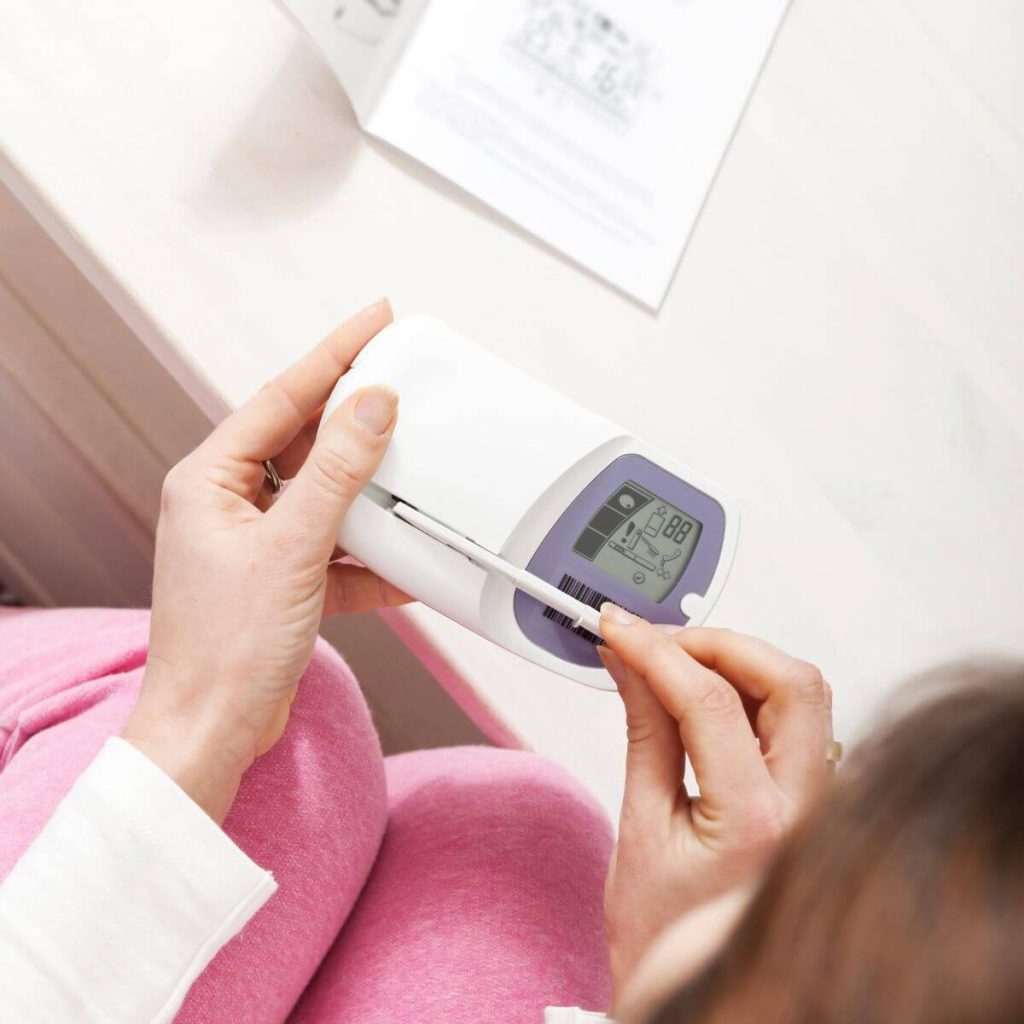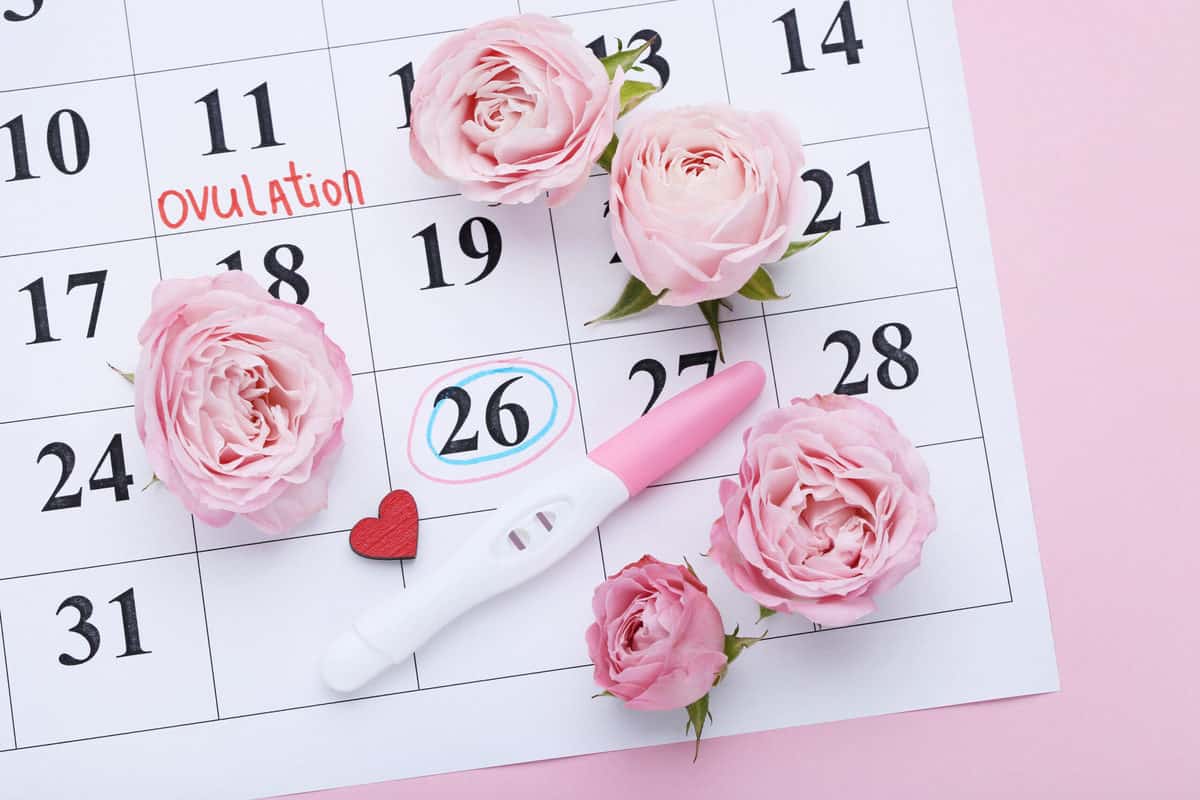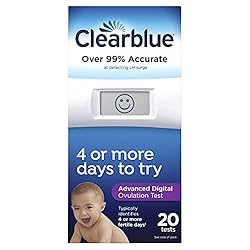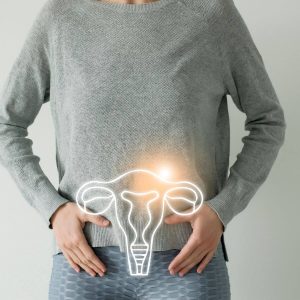This may come as a shock to some, but getting pregnant involves more than just doing the deed without a condom. It takes a delicate dance of timing, hormone levels, and just the right amount of sperm to make magic happen. That’s why so many people rely on the best ovulation tests on the market to help guide them.
Each month, the average 30-year-old person only has about a 20% chance of getting pregnant.
By pinpointing your exact fertile window each month when you can conceive, however, you can increase your chances of getting pregnant on ovulation day.
The longer you track your cycle and monitor ovulation day symptoms, the better you’ll become at understanding when you’re most fertile.
Ovulation is an integral part of the reproductive process. In fact, any list of tips to conceive worth its weight in salt will tell you that tracking your ovulation cycle is a good place to start when you’re struggling to get pregnant.
But how are you supposed to know?
Is there some unforeseen sign you’ve missed each month that lets you know when it’s time to hit the sheets with your partner?
Not exactly.
What we do have, however, are ovulation predictor kits. From test strips to ovulation tracker apps, there are plenty of amazing tools you can use to understand your reproductive cycle and determine when you’re ovulating during the month.
Despite the variety of available ovulation tracking devices, not every choice is a popular option. Some people, for example, prefer not to combine technology with reproductive health.
I, for one, had a hard time trusting that an app on my cell phone could accurately tell what was going on inside my body.
For people like me who prefer physical proof that they are or aren’t currently ovulating, ovulation test strips and other tests are a great option.
At-home ovulation tests provide accurate results, are easy to use, and help you determine when you’ll have the best chance of conceiving a baby…all without using an app.
The only problem is sifting through the options and picking a test that will suit your needs.
Lucky for you; however, we have an amazing community of parents who have used just about every product on the market. We’ve asked for everyone’s favorite fertility tracking options and are here to bring you the best of the best.

This site contains affiliate links, meaning that we earn a small commission for purchases made through our site. We only recommend products we personally use, love, or have thoroughly vetted.
- Why use an Ovulation Test?
- How accurate are Ovulation Tests?
- Using Ovulation Tests 101: Tips for Accurate Results
- How to read Ovulation Test Strips
- Reliable and Easy At Home Ovulation Test
- The Most Popular Digital Ovulation Test Kit: Clearblue Advanced Digital Ovulation Test
- Trusted Pregnancy & Ovulation Test Kit Bundles
- Easy at Home Ovulation Ovulation Test and Fertility Trackers for Long-Term TTC
- Jumpstart Your Fertility Tracking Experience Today
- Best Ovulation Test FAQs
Why use an Ovulation Test?
Many of the best ovulation tests available are urine-based tests that measure the amount of luteinizing hormone (LH) in your system. LH is a reproductive health hormone that spikes when a woman is near ovulation.
The hormone works to help the person’s egg reach the final stages of maturity in preparation for possible conception.
While levels of LH are in someone’s urine at all times, there is a significant spike in the 24 – 48 hour period right before ovulation.
By identifying this spike, you’ll have a better idea when you’re at your most fertile.
There are typically two different types of ovulation test kits, one that looks like a small piece of paper that you dip into a cup of urine. The other resembles a typical urine-based pregnancy test that you pee directly on.
There are several benefits to using ovulation tests, including:
- Many of the best ovulation strips boast up to a 99% accuracy rating
- These tests let you know when ovulation is approaching, not just when it’s already occurred, as with basal body temperature charting
- Unlike with your basal body temperature, ovulation test strips and other products can be used at any time of the day – not just right when you wake up before you get out of bed
- Many people are more comfortable using ovulation-tracking products than checking their cervical mucus for signs of ovulation
- Ovulation tests provide more precise information about your fertile days instead of the estimated dates you’ll receive from ovulation apps. A 2018 scientific study even concluded that mobile apps only yield a 21% accuracy rating.
- Ovulation testing products are much more cost-effective than fertility monitors like the Mira Fertility Monitor, unless you use the monitor over a long TTC journey
Note that there are a few cons to using ovulation tests. They do not confirm ovulation like BBT testing or using a fertility monitor. Also, some users experience multiple follicular stimulations, having 2 LH surges in one cycle even if they only ovulate once.
How accurate are Ovulation Tests?
Wouldn’t it be nice if there was some type of magical product that could tell you without a doubt that you’d get pregnant by having sex on a set time and date?
Sadly, though, nothing on the market today comes without at least some margin of error.
While ovulation tests have improved greatly over the years and are a valuable tool for the TTC community, they’re not perfect. There are, however, a few things you can do to increase your chances of receiving accurate results.
Using Ovulation Tests 101: Tips for Accurate Results
The first time I ordered ovulation test strips, I was overwhelmed by what I received in the mail:
A giant bag of small blue paper strips with ZERO instructions on how to use them.
I understood they were “urine-related,” but the ins and outs of using them were lost on me. You could buy the best ovulation test available, but it’s useless if you don’t know what to do with it.
What time should I use them?
Should I drink before using them?
How long was I supposed to wait for accurate results?
SO MANY QUESTIONS!
Luckily, I’ve learned a few things from my fellow moms since that confusing time in my life, and I’ve figured out how to use ovulation tests successfully!
Aside from following any directions that come with your ovulation tracking products, here are a few of the most common questions about using these tests correctly:
1. How to use Ovulation Test Strips, Kits, and Tests
Let’s start with the basics of using ovulation test strips and tests the right way.
As stated previously, there are two common types of ovulation test kits on the market:
- ones you pee directly on (these look like pregnancy tests)
- and ones you dip into your urine (these look like thin pieces of paper)
Remember to search your packaging for instructions – these will help you figure out what type of test you’re dealing with (I’ll cross my fingers for you that your product actually comes with some!)
Once you’ve “coated” your test in pee, the waiting game begins.
While most results only take about five minutes to appear, you should look to the instructions on your specific brand of home test for further information.
Some ovulation test kits only come with around a week’s worth of tests, which might not be enough to gain clear information about your fertile window.
Be sure to have a decent number of tests available, at least for the first couple of cycles.
When you do get a positive test, plan on having sex at least once a day for the next two to three days if you’re hoping to get pregnant.
If you want the best and quickest results possible, be on the lookout for changes in your cervical mucus, such as thickening, changes in color, or increased amounts.
These changes can help you figure out when ovulation might be approaching, so you’ll know when to start testing.
When should a woman take an ovulation test?
We recommend taking an ovulation test if you’re trying to conceive and want to identify your most fertile days. Ovulation tests detect the surge of luteinizing hormone (LH) that typically occurs 24-48 hours before ovulation.
But be aware that you can’t just take an ovulation test one day and expect an answer as to whether you’re ovulating. Most ovulation tests require you to start testing several days before you expect to ovulate. For some tests, this helps establish a baseline, while for others, it’s simply a way to ensure you don’t miss your fertile window.
We recommend purchasing your chosen ovulation test before or during your menstrual cycle and reading its specific instructions to ensure you test during the correct window for that test.
2. Best time to take Ovulation Test
One of the best things about ovulation test strips is that they don’t require you to use them first thing after waking up.
Before I turned to an ovulation test kit, I attempted to keep track of my basal body temperature.
The problem with this method was that when I first woke up in the morning (the best time for basal temp checking), my groggy mind didn’t care to remind me that I needed to stay still and check my temp.
Instead, I would hop out of bed searching for the coffee pot, only to remember halfway to the kitchen that I was supposed to temp. So, then I would creep back to bed and pretend I hadn’t moved a muscle.
Not the best way to achieve accurate results.
With ovulation test strips, on the other hand, you can take them ANY time of the day.
While some researchers believe there is still a chance that early morning testing could be beneficial, there are no clear indicators to prove this.
In fact, some studies have even shown taking these tests with your first pee of the day is not a good idea, as most women have an LH surge in the morning regularly.
The most important thing regarding the best time to use ovulation test strips is to try and remember to check at the same time each day.
3. Are There Rules About What You Can and Cannot Drink Before an Ovulation Test?
For a successful ovulation test result, the more concentrated the urine, the better.
This means that you should not only avoid peeing for one-to-two hours before testing, but you should also avoid drinking lots of water or other fluids before testing, as this can dilute the lh level in your urine and skew the results.
4. Will Ovulation Tests Work for Someone with Irregular Cycles?
Straight from the start of getting my period, I noticed that my menstrual cycle wasn’t as regular as other girls my age. I worried that tracking my ovulation wouldn’t be easy because of my irregular periods – fortunately, that wasn’t the case.
While irregular menstrual cycles can make ovulation tracking difficult, it’s not impossible.
For the best results, make sure you have plenty of tests to take over longer periods. You should also try to track other things happening with your cycle, such as the quality of your cervical mucus and basal body temperature.
And if you notice that you’re never getting the LH surge that signals ovulation, look into whether you might be experiencing anovulation instead.

How to read Ovulation Test Strips
Even when reading the best ovulation test, it sometimes involves a bit of troubleshooting.
While it might seem that getting a positive or negative answer is easy, certain situations require a little more consideration.
We’ve asked our community their questions about the results they’ve received from their ovulation test kits—here are the answers you need to know.
1. What does a positive ovulation test look like?
Most tests have some sort of control line for you to look at.
Occasionally, however, response lines will form that are fainter than the control line. Does this mean you’re ovulating or that ovulation is approaching?
Not exactly, since there’s always a small amount of LH in a person’s urine.
For this reason, it’s common to see a faint line appear on your test. But a faint test line equals a negative ovulation test–you are not about to ovulate when the line is faint!
For a true “positive result,” your test line should be as dark or darker than the control line on your test.
2. What does a blinking smiley face mean?
When it comes to fertility tracking, Clearblue ovulation tests are among the most popular options on the market, but they can be confusing.
During your ovulation testing cycle, there’s a chance you’ll receive a “blinking smiley face” result.
While this cheerful, excited emblem might instinctually feel like a sign your ovaries are in full egg-releasing swing, this isn’t necessarily true.
Instead, a flashing smiley face merely means your fertility is high – not necessarily that you’re at “peak fertility.”
For the ultimate in fertility-readiness, people should be on the lookout for the standstill smiley face emoji. This image represents the highest chance of conceiving.
Don’t worry, though–with a blinking smiley face, there is still a good chance you could become pregnant.
3. Will an ovulation test be positive if you’re pregnant?
Since the LH hormone and the hCG pregnancy hormone are molecularly similar, there’s a chance you could receive a positive ovulation test, even when you’re pregnant.
That said, there’s also a chance your ovulation test strips could be negative while pregnant.
If you’re suspicious that you might be pregnant, don’t rely on an ovulation test kit to provide you with answers. Traditional pregnancy tests are more sensitive to hCG and will give you the most reliable results.
Still not sure whether you’re actually pregnant or not?
When in doubt, always make an appointment with your doctor to have your concerns medically reviewed.
Reliable and Easy At Home Ovulation Test
With so many different types of ovulation test kits on the market, it can be hard to tell which ones you should trust.
If you’re interested in learning more about the best ovulation test strips of 2022, we’ve done the research for you!
1. Proov Predict & Confirm
We love the Proov Predict & Confirm Ovulation Test Strips because they’re the only FDA-cleared tests on the market that include tests to actually confirm ovulation. When I was trying to conceive, I kept being led astray by ovulation test strips because they would detect an LH surge that didn’t actually lead to ovulation. Use code “Undefining” to get 20% off your purchase at proovtest.com.
At the time, it required a high-tech fertility monitor to discover that I was actually missing my fertile window each month, but if the Proov Predict & Confirm Test Strips had been available at the time, I wonder if I might’ve discovered that my first LH surge wasn’t leading to ovulation much earlier.
2. Natalist Test Pack
Our favorite thing about the Natalist Test Pack is its easy-to-use, jargon-free instructions! Hard to come by with such tests, we love Natalist for their clear communication with TTC mamas.
This pack comes with 7 ovulation tests and 4 pregnancy tests and includes a subscribe-and-save option so you can have them conveniently delivered to your door each month.
3. Fairhaven Health Test Strip Big Bundle
We love products from Fairhaven Health because their research team is constantly looking for the most up-to-date information to support families trying to conceive.
Their big bundle of test strips includes 30 ovulation test strips (the kind you dip in a urine cup) and 10 early-detection pregnancy tests at a great price.
4. Pregmate Ovulation Test Strips
Another affordable option is Pregmate Ovulation Test Strips. Users love the Pregmate Ovulation Test Strips for their clear responses and easy usability.
Thanks to their low cost, many users mention choosing these strips to use as natural birth control instead of pills.
While many of the reviews on Amazon reference the reliability and accuracy of Pregmate strips, it is worth noting that some individuals experienced false positives. This could be a sign of a defective strip or could indicate an underlying medical issue.
If you’re concerned about the results, don’t hesitate to speak with your doctor or care provider.
The Most Popular Digital Ovulation Test Kit: Clearblue Advanced Digital Ovulation Test
While we’ve already mentioned the Clearblue ovulation test, the popularity of these at-home tests bears repeating.
This easy-to-use test boasts nearly a 5-star rating on Amazon and has more than 8,400 outstanding reviews.
It features a design similar to regular pregnancy tests and an approximate 99% accuracy rating. Plus, it’s one of the few ovulation test kits that include 20 individual tests.
This is a great option for anyone looking to use ovulation tracking as a natural birth control method.
One downfall to this test, however, is it might not work for hopeful parents struggling with fertility-related conditions, such as PCOS infertility that causes anovulation (the absence of ovulation) or irregular ovulatory cycles.
If you’re looking for more in-depth ovulation tracking options, there’s also a Clearblue Fertility Monitor that many people love.
Trusted Pregnancy & Ovulation Test Kit Bundles
While there’s no shortage of individuals who start ovulation tracking to learn more about their reproductive cycles, the most common reason for the practice is pregnancy-related.
If you’re looking to conceive, however, you’re probably going to need some pregnancy tests to go with your ovulation trackers – that’s why many amazing companies have bundles of both!
1. Easy@Home Ovulation Test Strips & Pregnancy Tests
Let’s face it, when we’re hoping to conceive, we will probably be anxious to take a pregnancy test once the two week wait after ovulation is over.
That’s where this amazing kit from Easy@Home comes in!
Not only does this budget-friendly option include 50 ovulation test strips, but it also comes with a convenient supply of 20 home pregnancy tests.
Are you wondering whether you should trust an ovulation test kit that’s so affordably priced?
Well, the 21,000+ reviews on Amazon are a good indication you can.
Many people have found success using these tests. For example, one reviewer struggled with PCOS and hypothyroidism but still managed to get pregnant after only a single cycle with these ovulation test strips.
In terms of negative reviews, it can be noted that some users received false negatives with the included pregnancy tests.
If you believe you’re pregnant and don’t get a positive, it’s worth speaking to your doctor or using a better home pregnancy test for confirmation.
2. Pregable Combo Kit
Much like the Easy@Home set, the Pregable Combo Kit comes with 50 ovulation tests and 20 pregnancy tests. One of the things I love about this set, though, is that you can also use it in conjunction with Pregable’s SmileReader app!
Simply plug in your results, and the app will help you figure out the days when you’re most likely to conceive during your 28-day cycle.
3. Pregmate Ovulation & Pregnancy Predictor Kit
With a sensitivity level of 25 MIU/ml, one of the best for ovulation tracking, the Pregmate ovulation and pregnancy predictor kit is one of the best fertility monitoring options on Amazon.
This set has nearly 8,000 reviews and impresses hopeful parents with its ability to predict ovulation accurately.
Note: One reviewer did mention that the included instructions only recommend dipping the test strip for 3 seconds. She had the best results when submerging it for at least 5 – 7 seconds.
4. MomMed Test Strips
The MomMed testing kit comes with 60 ovulation tests, compared to 50, and it also includes some convenient urine cups to simplify the “dipping” process.
It retails for less than $19 and is one of the top options if you’re searching for budget-friendly ovulation monitoring solutions.
Plus, many reviewers rave about how this product finally helped them overcome their conception struggles.
Easy at Home Ovulation Ovulation Test and Fertility Trackers for Long-Term TTC
Something I love about the previously mentioned products is how affordable they are – for short-term usage, that is!
While $20 here and there doesn’t seem like much, the cost adds up the longer you need to use ovulation monitoring tests.
It might be wise to consider alternative options if you’re battling a long-term infertility experience. There are a couple of incredible fertility-tracking products that are popular among the TTC community.
1. Mira Fertility Starter Kit
Are you looking for a more technologically-advanced ovulation testing kit? Then the Mira Fertility Starter Kit might be for you.
This state-of-the-art kit comes with a small device into which you’ll put your ovulation test directly.
The device will evaluate the hormone levels in your urine and provide results regarding your fertility. It’s also connected to an easy-to-read app for consistent tracking.
The downfall? The Mira ovulation tester is not cheap!
The device itself costs over $100, plus you’ll need to purchase additional urine tests based on your needs.
2. Ava Fertility Tracker
The first FDA-approved fertility tracker, the Ava bracelet, is a mainstay within the infertility community.
Worn only while sleeping, this device was created by a board of experts, including multiple reproductive endocrinologists. It tracks several different health components to provide accurate information about your fertility. Some of these statistics include:
- Temperature
- Movement
- Heart Rate
- Pulse
- Breathing Rate
The downfall to this product is that it costs a lot – $279, to be exact. For many users, though, the money is worth it. Reviewers state it was much simpler to use than traditional ovulation tests and provided the accuracy they relied on throughout their fertility journey.

Jumpstart Your Fertility Tracking Experience Today
It’s not always easy to keep track of your ovulation cycles without additional help. Thankfully, though, ovulation tests are a trusted solution that offers the reliable information you need about your reproductive cycle.
These single-use devices are constructed to provide accurate data you can use to learn when you are most fertile.
Whether you’re hoping to conceive or trying to avoid it, there are a plethora of different ovulation testing products available, depending on your budget and preference.
And remember, if you’re struggling to conceive, take control of the process.
Tracking your ovulation is a great first step in getting ahead of your worries and working towards the family you’ve been hoping for.
If you’ve used any of these products before, what would you say was the best ovulation test you purchased?
Best Ovulation Test FAQs
In most cases, you’ll be fertile for 24-48 hours after a positive ovulation test.
Ovulation tests work by detecting the presence of luteinizing hormone (LH) in a woman’s urine. LH is a hormone that is naturally produced by the body and plays a key role in the menstrual cycle. LH levels increase dramatically just before ovulation, triggering the release of an egg from the ovary.
Ovulation typically lasts for about 12-24 hours, although the exact duration can vary from woman to woman and cycle to cycle. During ovulation, the ovary releases a mature egg, which then travels down the fallopian tube where it can be fertilized by sperm.
Some of the main ways many fertility doctors recommend supporting ovulation include managing things like weight, stress, and nutrition, limiting alcohol and caffeine, and taking fertility supplements that are a fit for your unique body.




















